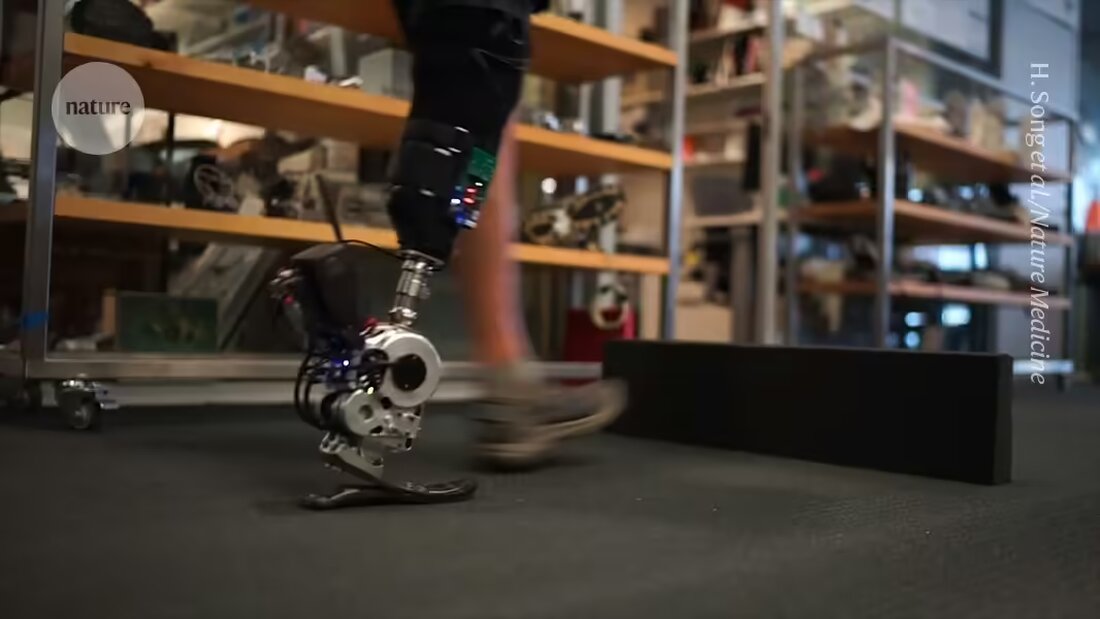A robotic leg that can be fully controlled by the brain and spinal cord has enabled seven people who lost a lower leg to walk about as fast as people without amputations.
The bionic leg uses a computer interface that amplifies nerve signals from the muscles in the remaining part of the leg, allowing the wearer to move the prosthesis using their own thoughts and natural reflexes.
In a 14-person clinical trial, participants with this interface were able to walk 41% faster than those with traditional robotic legs. They also had better balance and the ability to change speed, climb stairs and overcome obstacles. The results were announced todayNature Medicinepublished 1.
“This is the first study to show natural gait patterns with full neural modulation, where the person's brain has 100% control over the bionic prosthesis, not a robotic algorithm,” said study co-author Hugh Lord, a biophysicist at the Massachusetts Institute of Technology in Cambridge, at a press conference announcing the results.
“Although the leg is made of titanium, silicone and various electromechanical components, the leg feels and moves naturally, without conscious thought,” he added.
Herr had both legs amputated after he was stranded on ice on Mount Washington in New Hampshire during a blizzard in 1982. He says he would consider interface devices for his limbs in the future.
Muscle meets machine
Most existing bionic artificial limbs rely on preset algorithms to control movements and can automatically switch between predefined modes for different walking conditions. Advanced models have helped people with amputees walk, run and climb stairs more fluidly, but the robot retains control of the leg movement, not the user, and the device does not feel like a part of the body.
Determined to change this, Herr and his colleagues developed an interface that controls the robotic leg using signals from the nerves and muscles that remain after amputation.
Their clinical trial included 14 participants with below-knee amputations. Before wearing the robotic device, seven of them underwent surgery to connect pairs of muscles in the remaining sections of their legs.
This surgical technique, which creates an agonist-antagonist myoneural interface (AMI), aims to recreate natural muscle movements so that the contraction of one muscle stretches another. This helps relieve pain, maintain muscle mass and improve comfort with the bionic leg 2.
The bionic leg itself includes a prosthetic ankle equipped with sensors and electrodes attached to the surface of the skin. These capture electrical signals generated by the muscles at the amputation site and send them to a small computer for decoding. The leg weighs 2.75 kilograms, similar to the average weight of a natural lower leg.
Quick improvements
To test the system, the participants practiced with their new bionic legs for a total of six hours each. The researchers then compared their performance on various tasks with that of the seven other participants who had received conventional surgery and prosthetics.
The AMI increased the rate of muscle signals to an average of 10.5 pulses per second, compared to about 0.7 pulses per second in the control group. Although this represents only 18% of muscle impulses in biologically intact muscles - about 60 impulses per second - the participants with AMI were able to fully control their prostheses and walked 41% faster than those in the control group. Their peak speeds correspond to those of people without amputations when walking on a level path along a 10-meter-long corridor.
"I actually found it remarkable that they could do so well with so little learning," says Levi Hargrove, a neuroscientist at Northwestern University in Chicago, Illinois. “They would see even more benefit with a longer training period of wearing the device.”
Researchers also tested how well participants could handle various situations, including walking on a floor with a 5-degree incline, climbing stairs and overcoming obstacles. In all scenarios, AMI users demonstrated better balance and faster performance than people in the control group.
“It gives the user such a high degree of flexibility that is much closer to the biological leg,” says Tommaso Lenzi, a biomedical engineer at the University of Utah in Salt Lake City.
Natural experience
The technology offers new hope for people with amputations who want to regain natural walking. "People who have an amputation want to maintain control of their limbs. They want to feel like the limb is part of their body," says Lenzi. “This type of neural interface is necessary to achieve this.”
Improvements to the leg's design could reduce weight and optimize surface electrodes, which are sensitive to moisture and sweat and may not be suitable for everyday use, Lenzi says. Future studies will be needed to test whether the device can handle more demanding activities such as sprinting and jumping.
Herr says his team is already looking at ways to replace the surface electrodes with small implanted magnetic balls that can accurately track muscle movements.
This study “provides the foundation we need to then translate this into clinically viable technologies and solutions for everyone with an amputation,” says Lenzi.

 Suche
Suche
 Mein Konto
Mein Konto

